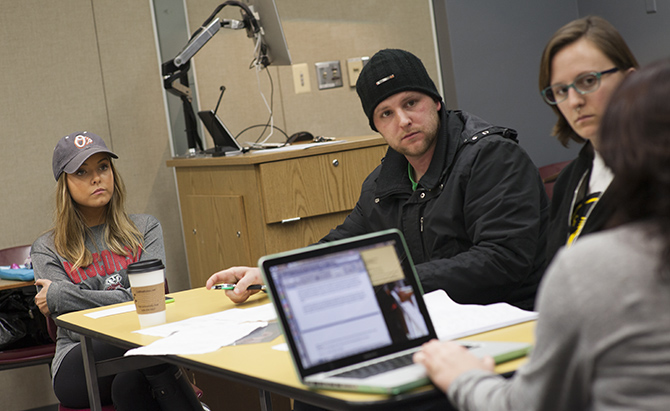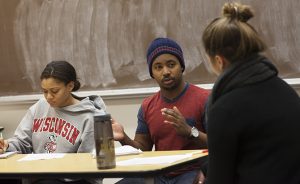
One of the Communication Arts courses Assistant Professor Sara McKinnon teaches is CA 671 – Communication and Social Conflict. Throughout the semester, her students put on mock conflicts in class and take turns mediating the conflicting parties. To find out more about mediation, I visited one such session and asked Professor McKinnon a few questions.
Can you talk a bit about what mediation is?
Mediation is a method of conflict resolution that facilitates parties in conflict to come to agreement about how to resolve the conflict. The process involves a mediator as a third-party to the conflict. The mediator’s job is to structure the interaction, maintain good communication throughout the process, and explore the issues and options for resolving the conflict. Mediators are not judges or arbitrators. They do not make decisions for the disputing parties. I like to think of the mediator as being an ideal communicator. Mediators listen attentively, give appropriate verbal and non-verbal feedback, affirm, attend to different conflict frames and punctuations, ask lots of questions, attend to power dynamics, provide space for people to express their interests and feelings, organize and structure conversation, and hopefully facilitate resolution. In other words, mediation is a lot of work!
Why do you teach mediation in your Comm Arts classes?
I like teaching this method in communication classes because students learn why their Comm Arts degrees matter! Most students who take the Communication and Social Conflict (CA671) class where I teach mediation have had other communication classes like interpersonal communication, argumentation, rhetoric, persuasion, group communication, and organizational communication. Mediation takes the research and theory from those areas and applies it as information about best practices in communication. It is so much fun to see the light bulbs of connections in students’ eyes as they see how much valuable information they’ve gained in their time with us.

What real-world application does mediation have for your students?
Most of my students will probably not become professional mediators, but I see this training as doing two things practically in their lives. First, it gives them a method for practicing good communication skills, which is something we all need practice in! This is immediately applicable as they interact in their personal, social, and professional lives. Second, it teaches students that there are alternatives to the court system and litigation when problems arise in our lives. Methods like negotiation, intergroup dialogue, conflict circles, and transformative justice, alongside mediation, are options that all of us have before us as we face conflicts that seem so big, so intractable, that we must seek outside help. Just knowing these methods are possible and available, I think, shifts students’ thinking and perspective about what it means to experience and resolve conflict.
Have you ever worked as a mediator?
Outside of my job researching and teaching at the university, I am also a mediator in the community! I am a regular mediator for housing disputes with the Tenant Resource Center (http://www.tenantresourcecenter.org/), and I am also available to mediate relational/family, cultural, and community-related disputes.